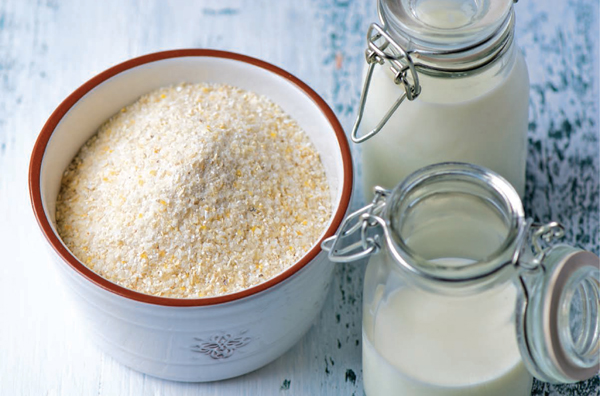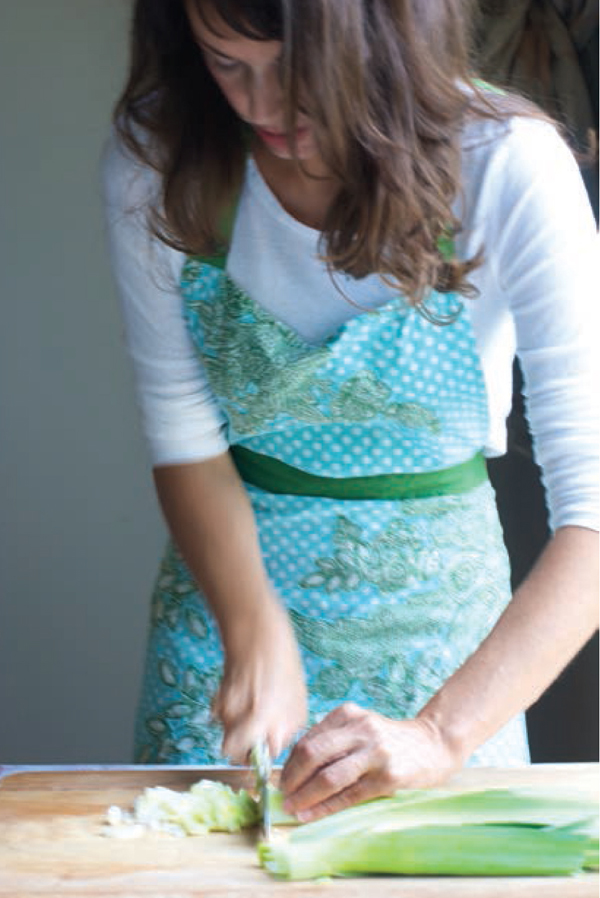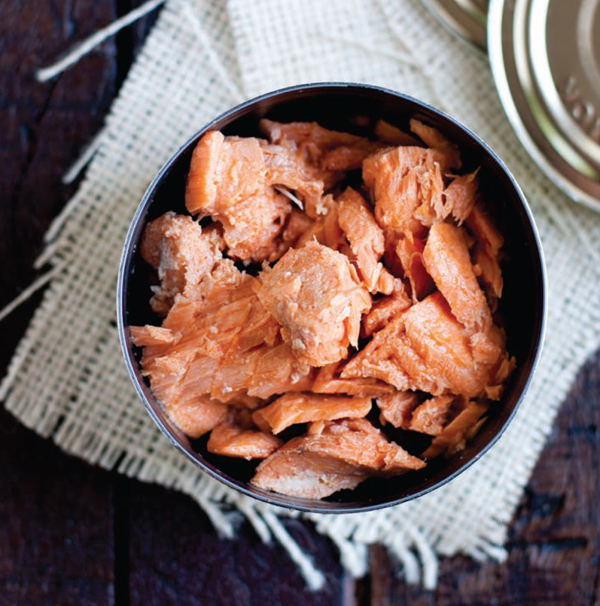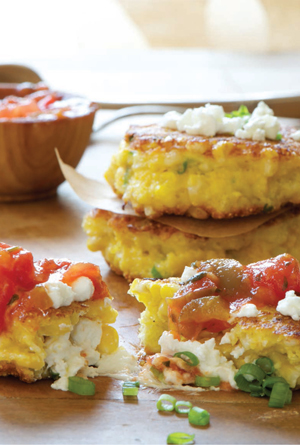
Savory Cakes, Some of My Favorite Things
I was such a tomboy. Which means, of course, that I loved to play in the dirt. In fact, I still like to play in the dirt and am so glad I have a son who likes to play in the creek like I did. It wasn’t that long ago that I got to teach Kelly how to find underneath the rocks and then carefully pick up a crawdad just behind its pinchers.

I also made mud pies as a child— even tasted them.
I believe it was a ploy by my mother to make me into a girl— about the same time, I started getting pretty things for my room, too— that led to my getting a Betty Crocker Easy-Bake Oven (they still make these). The results from the packaged mixes didn’t look much different from my mud pies but, oh, did they taste better (and less gritty). In 1979, that was some good stuff.
I don’t have much of a sweet tooth, but I do like savory things, so I have a propensity now to turn almost anything into a small savory cake. My fascination with turning black-eyed peas, okra, or even grits into a small cake might have something to do with my mud pie and Betty Crocker past.
There are the standard cakes out there that you will immediately recognize— crab cakes are one example— but feel free to experiment. Fish cakes and shrimp cakes are easy ones. Legumes are also fun to play with. I first had some black-eyed pea cakes at a restaurant more than ten years ago and they were truly delicious served with a salsa and grilled shrimp.
Cakes like these can be a main course if served with some interesting accompaniments.
And if you want to relive your childhood, let the little ones in on the making of these cakes. They can get their hands dirty in the process of squishing those peas and egg and breadcrumbs together. I promise the results will be much more delicious than the mud pies we used to make during those hot Alabama summers.
Sometimes wonderful, wonderful things are created from leftover elements. Artists know this and creative cooks know this. A favorite recipe of mine is one that uses leftover grits. This is a very old Southern recipe that uses leftover grits to make grit cakes, which can then be served for breakfast with syrup drizzled (or if you’re seven, poured rapidly until a thick pool covers your plate) on top. I am not certain of the origins but know that it has been around for a long time— especially in my family— although often when I ask other “old” Southerners about them, to my surprise, they have never heard of the recipe. Maybe this is one of those things that are contained— like on the Galapagos— and never make it to other locations.
The basic premise here is to take leftover grits and let them set up overnight (refrigerate to get cool and firm), then cut them into rectangles or squares, dip in egg and roll in cornmeal, and fry up golden brown. Serve them hot with butter and syrup.
As for me I will take savory over sweet any day and thus take the grit cakes and serve them with a fried egg and a little dash or two of Tabasco. So at my breakfast table there are two versions of this dish— the spicy one for me and the sweet for everyone else.
Another savory idea is to serve them with a light tomato sauce and shrimp. My son says I love leftovers for breakfast and it is true. I turn leftover vegetables into my frittatas in the morning, turn leftover beans also into cakes and serve with a fried egg. It is my chance— breakfast, that is— to relive last night’s pleasure in a new form. So I am glad to see, just as my seven-year-old is glad to see anything with syrup in the morning, grits get a second chance in the light of a new day.

Serves 4
4 cups chicken broth or water
2½ cups old-fashioned, stone-ground yellow grits
½ cup heavy cream
½ cup cornmeal
½ cup vegetable oil
Line a 9-inch square pan with wax paper. In a heavy saucepan, bring the broth to a boil and slowly stir in the grits. Simmer, stirring constantly, for 10 minutes. Stir in the cream and simmer, still stirring, another 10 minutes. Season it with the salt and pepper. The grits will be thick. Pour the mixture into the baking pan, smoothing the top with a spatula, and cool. Chill for at least two hours or overnight.
When the grits have cooled, sprinkle cornmeal onto a work surface. Invert the grits onto the cornmeal and remove the wax paper. Cut the grits into four squares and halve the squares diagonally to form 8 triangles. Coat each triangle with the cornmeal. In a heavy skillet, heat the oil over medium heat until hot but not smoking. Fry the grit cakes in batches until golden on both sides (about 3–4 minutes total), adding more oil if necessary to keep them from sticking. Drain them on a paper towel.
Place a couple of grit cakes on each plate. Top with a pat of butter and serve with warm maple syrup.
These potato cakes make a delicious side for steaks or pork roast.

Serves 4–6
6 medium potatoes, Yukon Gold
3 tablespoons fresh parsley, chopped
3 tablespoons green onions, sliced
8 ounces goat cheese, crumbled
2 tablespoons olive oil
Salt and pepper
¼ cup all-purpose flour
Preheat oven to 375 degrees.
Add whole, unpeeled potatoes to medium pot. Fill pot with cold water just to cover potatoes; season cooking water well with salt (it should taste like the sea) and bring up to a boil.
Boil on medium-high heat until potatoes are tender but not overdone, about 10–15 minutes. Drain, peel, and mash roughly with a fork.
When potatoes have cooled enough to handle, fold in fresh herbs, goat cheese and salt and pepper to taste.
Mix until just combined; pieces of goat cheese should still be visible. Form mix into eight 2½ x 1-inch cakes. Flour lightly and set aside.
Add olive oil to a large nonstick pan and bring up to medium-high heat. Add potato cakes and fry until first side is golden brown.
Flip onto other side, fry for another minute, and place in oven to finish warming through, about 10 minutes.
Okra is a Southern staple yet a much misunderstood food. Her bad reputation comes from the texture— slimy— she exudes if boiled for a period of time. There’s nothing slimy about the vegetable when used in the following method of preparation, which also gives you a wonderful way to use okra besides the standard breading and frying them— although there is nothing wrong with that. If you try these cakes and serve them as a side to any roast meat you won’t be sorry you did.

Serves 6
1 cup cornmeal
1 cup self-rising flour
2 teaspoons salt
2½ cups water
1 pound whole okra, sliced into ½-inch rounds
½ cup Vidalia onions, chopped
1 tablespoon vegetable oil
In a large bowl, whisk together cornmeal, flour, and salt. Whisk in water to make a thin batter. Stir in okra and onions.
Over medium heat, add vegetable oil to a cast-iron skillet. Use a small ladle to pour batter onto skillet. Pan should be hot enough to make batter sizzle. Cook until underside is browned, about 3–4 minutes, then flip and brown on the other side. Repeat with additional batter adding more oil to pan as necessary.
Salmon Cakes (We Called Them Patties)
Everyone, I am certain, has a food that warmly and gently, if not perhaps slightly embarrassingly, takes them back to the dinner table of their childhood. If you are like me and spent your adolescent years in the ’70s, then you recall that “gourmet” wasn’t a word often used in the average American home. Neither, certainly, was the word “foodie.” I am good with that and with my culinary past bespeckled with Campbell’s soup cans and casseroles. I am. Nevertheless, I am also proud to say that a great number of classic Southern dishes are experiencing a revival and getting the nod from the culinary world that they deserve, and being uplifted and updated in wonderful ways.
But the meal I sometimes crave, prepare, and thoroughly enjoy every bite of is probably not ever going to experience any such revival, I have to say, and please don’t hold this against me or judge me any less of a fresh food champion because I go to this dish so willingly and without shame.
My mom called them “salmon patties,” not salmon croquettes or any such fancy name, and they were made from canned salmon. Unless you were lucky enough to grow up in the Pacific Northwest you probably didn’t have ready access to fresh salmon in the ’70s. Not that I am making any excuses for the fact that I use canned salmon today because, as you know, I could get fresh at any market within five miles of me. I used canned salmon because that is what my mother did. And I loved the result. And even worse you might think than loving salmon patties made this way, and revisiting them this afternoon, is that I, an eight-year-old girl, ate them dipped in … ketchup.
Now you might be granting me a little leeway to go back to my childhood comforts and experience this dish— reliving a few unseemly food memories is okay you might think, but a grown-up woman with a sophisticated palette would certainly, I am sure you are saying to yourself, modernize or elevate the “patties” and serve them with a remoulade or a creative aioli of some sort, maybe something with capers or at least a little lemon.
But you would be wrong. I made them today just as my mother did (well, I added a bit of Dijon mustard to the mix) and I did it, I ate them dipped in ketchup.
You are probably thinking you will never ever, ever, eat goat cheese made by a woman who would actually prepare, eat and enjoy such a meal. But I would like to implore you to trust my culinary instincts.
Food for me, I am sure you have heard me say this before but it never hurts to repeat myself, is about emotion. It is about the love and comfort that you feel when someone prepares a meal for you or even when you prepare a meal for yourself. There is succor in it, there is celebration in it. Food is about feeling comfortable coming to the table and not being intimidated because you cannot pronounce chèvre or croquette. I hope you feel the same.
1 can red salmon, drained, with skin and bones removed
1 egg, beaten
1 teaspoon Dijon mustard
1 tablespoon green onions, chopped
A dash or two hot sauce
2 tablespoons all-purpose flour (adding a bit more, if needed, to bind)
Olive or vegetable oil for frying
In a good cast-iron skillet, heat oil over medium hot heat. Combine all ingredients and form into patties. Fry until crispy on both sides, about 3 minutes each side.
Serve with a good remoulade, a nice aioli, or ketchup.
Serves 6
2 15-ounce cans black beans, drained well
6 green onions, finely chopped
¼ cup red bell pepper, seeded and finely chopped
¼ cup yellow bell pepper, seeded and finely chopped
¼ cup fresh cilantro, chopped
2 large cloves garlic, minced
1½ tablespoons jalapeño pepper, seeded and minced
2 teaspoons cumin, ground
1 large egg
2 tablespoons plus 1 cup yellow cornmeal
Olive oil for frying
Place drained beans in large bowl. Using hand masher, mash beans coarsely. Mix in green onions, bell peppers, cilantro, garlic, jalapeño, and cumin. Season to taste with salt and pepper. Mix in egg and 2 tablespoons cornmeal.
Place remaining 1 cup cornmeal onto flat surface covered with wax paper. Drop heaping 1 tablespoon of bean mixture into cornmeal; turn to coat. Flatten into ½-inch-thick cake. Repeat with remaining bean mixture and cornmeal, forming 10–12 cakes.
Heat 3 tablespoons oil in heavy large skillet over medium heat. Working in batches, fry bean cakes until firm and crisp, adding more oil as needed, about 6 minutes per side. Drain bean cakes on paper towels. Transfer to platter.
Serve warm with sour cream and your favorite salsa.
I love these little crispy cornbreads! They date back far into our national history as an adaptation of an original Native American recipe— called ash cakes— as they could be made over a fire. George Washington was said to enjoy these for breakfast. Why they then became a more Southern fare I don’t know. They are good for breakfast served like a pancake but I like them as a bread served alongside a main course or soup.
Serves 6
1 cup cornmeal
½ cup all-purpose flour
2 teaspoons baking powder
¼ teaspoon salt
1 egg
1 cup buttermilk
Oil or clarified butter for frying
Pre-heat a cast-iron skillet. Stir the dry ingredients together in a bowl. Mix in the egg and milk. Spoon the batter into the heated skillet or cast-iron griddle and fry like you would a pancake but till they are a little crispy on each side. Serve with butter.

Serves 4
2 tablespoons plus 1 teaspoon extra-virgin olive oil
3 cups corn (from 3 ears corn)
2 green onions, very thinly sliced, divided
2 large eggs, lightly beaten
¼ cup cornmeal
Coarse salt and pepper
2 ounces goat cheese, crumbled
In a large nonstick skillet, heat 1 teaspoon oil at medium temperature. Add corn and half of green onions and season with salt and pepper; cook until vegetables soften slightly, 3–5 minutes. Coarsely purée half of the corn and green onions in food processor. Transfer puréed and other half of whole kernel sautéed corn to a medium bowl and let cool, 5 minutes. Add eggs, remaining green onions, and cornmeal to corn mixture and stir to combine.
Wipe skillet, then heat 2 tablespoons oil on medium. In batches, cook cupfuls of corn mixture until set on bottom, about 3 minutes. Flip and cook until cakes are cooked through, 2 minutes. Transfer to a plate. Sprinkle corn cakes with goat cheese.
Serve these alongside any grilled meats or seafoods during those late summer meals. They can also be served on their own with a little salsa on top as a first course or appetizer.
This recipe is simply a more unique variation on the classic crab cake. I like them for appetizers especially.
Serves 4–6
16 uncooked large shrimp (about 1 pound), peeled, deveined
1 large egg
1 green onion, sliced
2 tablespoons lime juice, freshly squeezed
1 tablespoon mayonnaise
1 tablespoon fresh cilantro, minced
½ teaspoon hot pepper sauce
½ teaspoon salt
Pinch black pepper, freshly ground
1 cup cornmeal
2 tablespoons (or more) vegetable oil
Coarsely chop shrimp in processor. Add egg, green onion, lime juice, mayo, cilantro, hot pepper sauce, salt, and pepper. Blend in using on/off turns. Add 1 cup cornmeal and blend in using on/off turns. Form mixture into twelve 3-inch-diameter cakes. Heat 2 tablespoons vegetable oil in heavy large skillet over medium-high heat. Working in batches, fry cakes until cooked through and golden brown on both sides, adding more oil to skillet as needed, about 6 minutes.
Serve with spicy mayonnaise.
Spicy Mayonnaise
1 cup mayonnaise
2 tablespoons chili garlic sauce (found in Asian food section of grocery store)
1 teaspoon lime juice, freshly squeezed
Combine all ingredients in mixing bowl.
Asian Dipping Sauce
½ cup soy sauce
½ cup rice-wine vinegar
2 tablespoons honey
3 cloves garlic, minced
2 tablespoons ginger from ginger root, minced
2 teaspoons sesame oil
Whisk together all of the ingredients in a bowl.
Salsa
6 Roma tomatoes, chopped
4 cloves garlic, minced
2 jalapeños, seeded and minced, plus 2 jalapeños, roasted, skinned and chopped
½ red onion, finely chopped
1 tablespoon olive oil
1 lime, juiced
Chili powder, salt, and pepper, to taste
Fresh scallions, cilantro or parsley, chopped, to taste
In a bowl, combine all ingredients. Place in refrigerator for 2 to up to 12 hours.

Serves 4–6
1 cup dried black-eyed peas
3 cups water
1 egg, beaten
½ cup onion, finely chopped
3 tablespoons lime juice, freshly squeezed
½ teaspoon hot pepper sauce
1 cup all-purpose flour
1/3 cup goat cheese
1 tablespoon jalapeño peppers, seeded and minced
2 teaspoons (about) olive oil
Salsa, medium-hot, prepared
Place dried black-eyed peas in medium pot. Add enough cold water to cover by 3 inches; let stand overnight. Drain peas.
Return peas to pot. Add 3 cups water. Cover; simmer until peas are tender, stirring occasionally, about 40 minutes. Drain peas, reserving 1/3 cup cooking liquid.
Cook’s note : One 16-ounce can of black-eyed peas can be substituted for the dried peas. Begin recipe here; rinse canned peas well before using.
Transfer 1¼ cups peas to processor and purée until smooth, adding enough reserved cooking liquid 1 tablespoon at a time to help blend. Transfer purée to a large bowl. Mix in beaten egg, onion, lime juice, hot pepper sauce and remaining whole peas. Stir in flour. Season with salt and pepper.
Mix goat cheese and jalapeño peppers in small bowl. Let stand 30 minutes.
Preheat oven to 250 degrees. Heat ½ teaspoon oil in heavy large skillet over medium-low heat. Using 1½ tablespoons batter for each pancake, spoon batter into skillet. Cook until batter is almost set, about 3 minutes. Turn pancakes over; cook until cooked through. Transfer pancakes to baking sheet; keep warm in oven. Repeat with remaining batter, adding more oil to skillet as needed, making 24 pancakes.
Spoon salsa onto plates. Arrange 4 pancakes alongside salsa on each plate. Top with goat cheese mixture and serve.